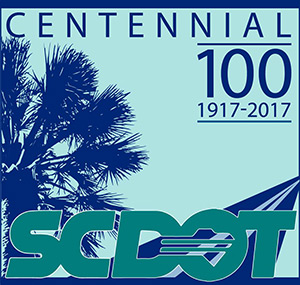100 Years of Controversy and Potholes at South Carolina Department of Transportation
The S.C. Department of Transportation turned 100 years old March 10.
The department was controversial almost from its first day. Many of the questions then — who would pay for roads, where should they be built and who would govern the agency — are being asked today.
Here, a look at some of the highlights from the department’s history.
S.C. Roads at the Start
Late on the afternoon of Saturday, March 10, 1917, five men gathered in the office of Gov. Richard I. Manning to establish the S.C. State Highway Commission, John Hammond Moore wrote in “The South Carolina Highway Department 1917-1987,” his history of the agency.
“At the time, an original $15 tax on sales of an automobile or truck and 25 cent per horsepower license tag fee paid for the agency. That yielded $101,948.80 from 38,322 vehicle owners and $7,881.50 from 642 auto dealers and another $957.17 from 1,210 motorcyclists,” Moore wrote.
When the agency was founded the key questions included where roads would be built, “when, by whom, who would pay for them, and who would control them.”
Those same questions exist today.
1920s
In 1920, the General Assembly created a new seven-member commission — one member from each congressional district in the state — to oversee the roads agency. Commissioners were appointed by the governor and approved by the state Senate.
The agency was given the state’s 411 miles to maintain.
By the end of 1922, the agency maintained 3,662 miles of highway, only 158.8 of which were paved.

Today, it controls about 41,000 miles of roads.
License fees were changed from being calculated based on a vehicle’s horsepower to its weight. That increased revenue to the department, despite fewer vehicles being registered in 1921 because of the severe agricultural depression that then gripped the state, on the eve of the Great Depression.
In 1922, the state Legislature approved a 2-cent-a-gallon gas tax. In 1925, that tax was raised to 5 cents, then the highest in the nation.
Today, the state’s gas tax is 16.75 cents a gallon. Alaska is the only state with a lower gas tax.
Mutiny at the Department
Armed with machine guns and the governor’s orders, a militia seized the state’s highway department on Oct. 28, 1935, stripping power over the state’s roads from what S.C. Gov. Olin D. Johnston called the “highway ring.”
The call for martial law came after Johnston accused the highway commission of inciting “rebellion and insurrection” by refusing to seat his appointees.
Machine guns, meant to block the commissioners from entering the department, greeted employees reporting for work. They were asked to resign unless they could continue working as “loyally and as faithfully” as they had before. Johnston installed six allies to run the roads agency.
The occupation of the highway department ended two months later when the state S.C. Legislature agreed, in an emergency session, to give control of the agency to a provisional board.
Eventually, Johnston lost the battle. He wanted the General Assembly to approve allowing voters to elect highway commissioners.
Instead, lawmakers stripped the governor of his power to appoint commissioners.
‘Welcome to South Carolina. See the Best State on the Best Roads’
Post-World War II, South Carolina’s secondary highways — the “farm-to-market” roads — were paved.
“(W)ith the whole-hearted approval of political and community leaders, hundreds of long-neglected country roads shed mud, sand, and dust for a permanent, all-weather surface,” Moore wrote.
In the 1950s, road-building highlights included the initial construction on a four-lane highway — between Aiken and Augusta — and the construction of beach groins to stem erosion and protect island roads.
Secretary Christy Hall announces launch of SCDOT’s Centennial website, where we have some great historical info https://t.co/2dFajKfdCx pic.twitter.com/Bf3KAwWMls — SCDOT (@SCDOTPress) March 10, 2017
In 1952, signs were posted at the state’s borders that read: “Welcome to South Carolina. See the Best State on the Best Roads.” The agency also started using asphalt to pave highways instead of concrete.
In 1956, the first contract for an S.C. interstate project was awarded for the construction of a bridge over the Broad River in Cherokee County.
Modern Natural Disasters
Since 2014, S.C. roads have weathered ice, historic rain and a hurricane.
In the aftermath of the 2014 ice storm, road crews cleared highways of limbs and trees that had broken under the ice’s weight.
The historic 2015 rains washed out or damaged more than 500 roads and bridges. The aftermath of flooding also focused attention on highways atop privately owned dams. Nineteen of those roads still are washed out as the Transportation Department waits for dam owners to repair or abandon the structures.
During last fall’s Hurricane Matthew, 481 roads and bridges were closed. The agency also reversed the direction of traffic on Interstate 26 for about 44 hours to help evacuate coastal residents.
S.C. roads today
Today, the S.C. Department of Transportation, led by Secretary Christy Hall, maintains about 41,400 miles of roads and more than 8,400 bridges, the country’s fourth-largest state-maintained highway system.
That system is crumbling; 83% of its pavement is in poor or fair condition. The state also has the nation’s deadliest roads, based on 2014 data.
The agency is expected to have a $2.1 billion budget in the fiscal year that starts July 1, roughly half of which comes from federal dollars.
The biggest state source of funding comes from the 16.75-cent-a-gallon gas tax, the second-lowest in the nation. That tax has not been increased since 1987.
Meanwhile, lawmakers continue to debate increasing the gas tax to send more money to the agency to repair roads and bridges.
Jamie Self contributed.
SOURCE: Information on the history of the Department of Transportation comes from John Hammond Moore’s “The South Carolina Highway Department 1917-1987.”
Distributed by Tribune Content Agency, LLC




